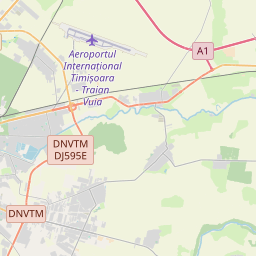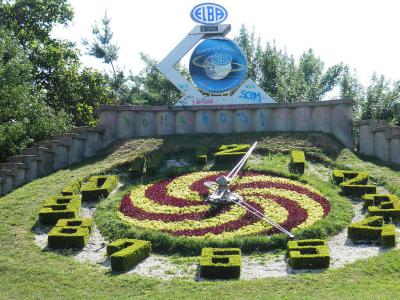
Timisoara Introduction Walking Tour (Self Guided), Timisoara
One of the largest cities in Romania, Timisoara holds an honorary spot on one's travel map. One will be thrilled with the city’s harmoniously grouped landmarks and of course, it is incredible that the city houses quite a number of squares with historical value. Are you curious to visit Timisoara? Check out the city’s prominent landmarks.
How it works: Download the app "GPSmyCity: Walks in 1K+ Cities" from Apple App Store or Google Play Store to your mobile phone or tablet. The app turns your mobile device into a personal tour guide and its built-in GPS navigation functions guide you from one tour stop to next. The app works offline, so no data plan is needed when traveling abroad.
Timisoara Introduction Walking Tour Map






Guide Name: Timisoara Introduction Walking Tour
Guide Location: Romania » Timisoara (See other walking tours in Timisoara)
Guide Type: Self-guided Walking Tour (Sightseeing)
# of Attractions: 15
Tour Duration: 2 Hour(s)
Travel Distance: 3.6 Km or 2.2 Miles
Author: HelenF
Sight(s) Featured in This Guide:
Guide Location: Romania » Timisoara (See other walking tours in Timisoara)
Guide Type: Self-guided Walking Tour (Sightseeing)
# of Attractions: 15
Tour Duration: 2 Hour(s)
Travel Distance: 3.6 Km or 2.2 Miles
Author: HelenF
Sight(s) Featured in This Guide:
- Sfânta Treime Statue (Holy Trinity Statue)
- Casa cu Lei (House of Lions)
- Palatul Bruck (Bruck House)
- Baroque Palace
- Timisoara Art Museum
- Cardinal Point Fountain
- Maria Theresia Bastion
- Ceasul Floral (Floral Clock)
- Copacul Breslelor (Guilds Tree)
- Piata Libertatii (Liberty Square)
- National Opera House
- Piata Victoriei (Victory Square)
- Palatul Lloyd (Lloyd Palace)
- Timisoara Orthodox Cathedral
- Castelul Huniade (Huniade Castle)
1) Sfânta Treime Statue (Holy Trinity Statue) (must see)
Between 1738 and 1739, Timisoara was decimated with plague, which caused the death of 1000 people. After this epidemic was over, the Sfânta Treime statue was built as a sign of gratefulness towards God. The monument was built in Vienna between 1739 and 1740; it has a high column around which statues are grouped, and Sfânta Treime is in the top part of the column.
2) Casa cu Lei (House of Lions) (must see)
The House of Lions is located in Piata Unirii (Unirii Square), right in the very heart of Timisoara. In the past it was the residence of Prince Eugeniu de Savoya. The house was constructed near Vienna Gate, which existed a long time ago where Marasti Square stands today. Along with many other old buildings in Timisoara, this two-storey house represents one of the most valuable treasures of the city.
3) Palatul Bruck (Bruck House) (must see)
Brück house or palace is an amazing, colorful building located in Piata Unirii. It was built in 1910 by Hungarian architect Szekely Laszlo in Art-Nouveau and Secession styles, with a mildly eclectic character. It is a four-level building; there is a drug store at the ground floor. The construction is quite popular among tourists for its outstanding, unusual, majestic design.
4) Baroque Palace (must see)
Baroque Palace is a historical building located in Piata Unirii. Since its construction, the palace served several purposes, namely military and administrative. In the present time, the palace houses the Museum of Art; the features of the building contributed to its election for the museum’s location.
5) Timisoara Art Museum (must see)
The history of the art collection begins with the Banat Museum’s establishment in 1872. To the humble beginnings of the actual section of art, dating back to 1879 when the first painting was registered, is added an important donation from Ormòs Zsigmond’s collection, who was one of the museum’s founders, in the period between 1888 and 1895.
His donation, which included Italian, Dutch, German, Austrian, Hungarian and Romanian paintings, formed the nucleus of the Timisorean museum. In 1979, the Art Section of the Museum had a collection of 7000 pieces, which from 1987 continued to evolve under a new roof in the west wing of the Baroc Palace, located in Piata Unirii. Since 2006, the Art Section is an independent museum.
His donation, which included Italian, Dutch, German, Austrian, Hungarian and Romanian paintings, formed the nucleus of the Timisorean museum. In 1979, the Art Section of the Museum had a collection of 7000 pieces, which from 1987 continued to evolve under a new roof in the west wing of the Baroc Palace, located in Piata Unirii. Since 2006, the Art Section is an independent museum.
6) Cardinal Point Fountain
The Cardinal Point Fountain is a modern symbol of the city. It is a rare finding for tourists, because Timisoara bursts with old buildings and historical sights. The artesian fountain’s magnificence can be observed fully, especially at night, due to the city’s lighting. It has a circular form and its name comes from the four cardinal points present on the superior part of the construction.
7) Maria Theresia Bastion (must see)
Maria Theresia Bastion was built between 1730 and 1735 and it is the largest piece of wall belonging to the old fortress of Timisoara, which still stands today. The initial fortress had 9 bastions. Today, the bastion is used as a passage. It also houses commercial buildings, restaurants, bars, a disco, a library and two permanent exhibitions of the Banat Museum.
8) Ceasul Floral (Floral Clock)
The Floral Clock, built in the eighties by ELBA factory, is an amazing composition of imagination and handy human skills. The clock is of a circular form and its numbers are “cultivated” out of flowers. It is really famous among locals; it serves as a meeting place, especially for young people. One who has a passion for nature ought to see this masterpiece.
9) Copacul Breslelor (Guilds Tree)
The house, which once belonged to the Journeymen’s Association in Timisoara, is famous for the Guilds Tree, at the corner of the building. This tree was a tree trunk dressed in iron and fixed into the wall with a metal bar and locked with a special padlock that didn’t have a key slot. The journeymen would bring a nail that had a big head, engraved with their names and initials, and they would hammer it into the trunk. The tree trunk exposed at the corner of the building is not the original one; that one is kept at the Banat Museum.
10) Piata Libertatii (Liberty Square) (must see)
Prince Eugeniu de Savoya Square was built in the middle of the 18th century. For an unknown period of time, it was known as Military Square or Parade Square. In 1848, when the Hungarian revolution began, the square changed its name to Liberty Square. This important landmark hosts old buildings and monuments, such as the Army House and Saint Mary Statue; the square is the city’s military center.
11) National Opera House (must see)
The National Opera House’s structure underwent many changes over time. Its construction started in 1871, according to the plans of two Viennese architects Fellner and Helmer, and was completed in 1875. There were two major fires which devastated the building. The first took place in 1880 and the second in 1920. The result was that only the lateral wings remained intact. The novelty Opera House hosts four art institutions: Romanian National Opera, National Theater “Mihai Eminescu”, German State Theater and Hungarian “Csiky Gergely” Theater. They are quite unique.
12) Piata Victoriei (Victory Square) (must see)
Victory Square, formerly Opera Square, is the place where Timisoara was proclaimed the first independent city in Romania on the 20th of December, 1989. At the opposite poles of the square one will find in the north - the Opera House and in the south - the Metropolitan Cathedral. The center of the square is decorated with monuments, such as “Lupoaica cu puii”, which is a replica of Lupa Capitolina; the monument was Rome’s gift for Timisoara in 1926. Another landmark located in Victory Square is the Artesian Fountain, also known as the Fountain with Fish, in the shape of a star with 5 corners. It was built in 1957.
13) Palatul Lloyd (Lloyd Palace) (must see)
Lloyd Palace is a monumental venue, which was built between 1910 and 1912, according to the plans of architect Leopold Baumhorn. The building’s architecture is eclectic with influences of secession. Before the Second World War, on the palace’s ground floor there was a Café, where the city’s elite would meet. Today, the palace serves as the seat of the Polytechnic University’s rector.
14) Timisoara Orthodox Cathedral (must see)
The Timisoara Orthodox Cathedral is a Romanian Orthodox cathedral in Timisoara, Romania. It was built between 1937 and 1940. It is dedicated to the Three Holy Hierarchs, Saints Basil the Great, Gregory the Theologian and John Chrysostom. It has 11 towers, of which the central and the highest are 96 meters high. It is home to many valuable religious objects such as old icons and early writings in Romanian, such as the 1648 Noul Testament de la Bălgrad and the 1643 Cazania lui Varlaam. The building's style is quite unusual among Romanian Orthodox buildings, although it is partly based on local religious tradition and partly on Byzantine architecture. Elements such as niches under the eaves, starry vaulting in the interior and lacquered discs in a variety of colours, can be seen in monasteries such as Cozia or Prislop. The church's interior and exterior paintings were created by the painter Atanasie Demian.
Sight description based on Wikipedia.
15) Castelul Huniade (Huniade Castle) (must see)
Huniade Castle is the oldest building in Timisoara. It was built between 1443 and 1447 by Iancu de Hunedoara, on the ruins of an old castle from the 14th century. Despite numerous changes, the castle kept its boundaries within a quadrangle yard, the position of the donjon tower and “Knights Chamber”. The castle’s tower has a rectangular form, small height and little windows; the roof is not visible, due to some decorations at the top.
Walking Tours in Timisoara, Romania
Create Your Own Walk in Timisoara
Creating your own self-guided walk in Timisoara is easy and fun. Choose the city attractions that you want to see and a walk route map will be created just for you. You can even set your hotel as the start point of the walk.
Palaces and Castles Walking Tour
The “Little Vienna” has amazed thousands of curious eyes for many years. This is thanks to the stunning palaces built in various styles, meant to lure visitors from all over the world. Take this tour to appreciate the most important historical buildings in Timisoara.
Tour Duration: 2 Hour(s)
Travel Distance: 2.0 Km or 1.2 Miles
Tour Duration: 2 Hour(s)
Travel Distance: 2.0 Km or 1.2 Miles
The Most Popular Cities
/ view all
















